Involve high-altitude cordyceps collectors into environment protection and sustainable waste management, the crucial challenge for Bhutan conservation institution UWICE
Involve high-altitude cordyceps collectors into environment protection and sustainable waste management, the crucial challenge for Bhutan conservation institution UWICE
Project Status: from December 2015
GOALS AND OBJECTIVES
Through this project, the Ugyen Wangchuck Institute for Conservation and Environment (UWICE) intends to create awareness to the cordyceps plant collectors on the importance of proper garbage management strategies and consequences of pollution. The objectives are to develop sustainable practices and create enough garbage disposal sites. The Institute expects that from the subsequent years after the implementation of the project, we shall see improved landscapes in the alpine belt of Bhutan and especially the Bumthang area.
Since its legalization, the alpine area of Bhutan is flooded with cordyceps collectors for a period of a month (generally Mid-May to Mid-June) and garbage has turned out to be a major issue in the pristine alpine environment of the country. Cordyceps collectors carry ration and other essentials to last for a month. There are no proper garbage disposal strategies adopted in the collection areas and camping grounds and people throw garbage everywhere, often in very remote places.
From 2014, new rule to reduce garbage was implemented. In the new rule, before issuing the Certificate of Origin (CO), the concerned forest officers are required to organize at-least two days of clean-up campaign to ensure that the garbage is disposed properly.

HOW DOES IT CONTRIBUTE TO MOUNTAIN PROTECTION
Alpine environment of Bhutan has remained largely un-touched for thousands of years, however with recent economy opportunities offered by cordyceps, it now sees many people. Cordyceps in Bhutan are found above 4500 meters above mean sea level. These people, while spending one whole month in the alpine area, not only uses the last available woody vegetation to burn as fuel but, litters the area. This project shall focus on managing the garbage and to create awareness to the collectors through information and services.
Managed by a group of researchers who shall be guided by the project manager, the project will help people sensitize on the importance of maintaining clean and proper alpine environment for all times to come. This sensitization will also focus on the need to preserving water downstream and minimize the disturbances to some of the last remaining charismatic animals.
COLLABORATION WITH LOCAL COMMUNITIES AND AUTHORITIES
This project shall indirectly benefit local communities, as it shall be implemented within the administrative boundary of where collection of cordyceps is allowed. To implement this project, proper consultation work with the local authorities will be undertaken and thorough sensitizing workshop to the people who go to collect cordyceps every year will be conducted. The workshop shall be conducted within the communities to encourage more participation and to reach to the people who should be informed. In-order to ensure, maximum participation, officials from local government and park officials will be involved.
Local government officials are involved in issuing permits to collect cordyceps and park officials are involved in monitoring the activities in the collection ground. I have good association with the communities as I worked in close collaboration with them in 2010 – 2012 to understand the fuelwood consumption pattern by the communities to understand its sustainability.

GOING FURTHER THAN “BUSINESS AS USUAL”
Cordyceps are known to occur in the alpine areas of Bhutan, China, India and Nepal where it is extensively collected every year. The issue of garbage and its consequences (water and soil pollution, fauna endangered) reaches all the countries where the plant is collected. Though, garbage has been seen as a big problem in the alpine environment of mountains, it has largely remained as an issue without much work being undertaken to control it. If the project remains a success, the same practice can be replicated in all the regions to help protect and save mountain environment at large.
More information on the environmental impact of cordyceps collection.
CONTACT
Sangay Wangchuk
sangaywk@gmail.com
uwice.gov.bt

